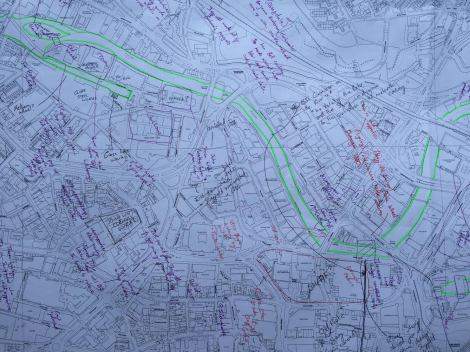
After the success of our Belper project which I wrote about in March and April, we’ve brought our mapping closer to (my) home in Sheffield to look in more detail at the River Don. As Sheffield’s major river, the Don is one of five watercourses that passes through the city, has had a tumultuous history at the centre of one of England’s most industrialised cities though with a human history that dates back much further. It’s endured having a Norman castle complete with sluice built on its confluence with the River Sheaf and Kelham Island being created by a millrace sometime in the twelfth-century. By the nineteenth-century the river had 150 mills using the power of its water and for much of the industrial revolution it was one of the most polluted rivers in Britain thanks to the steel factories on its banks. Clearly then, the Don provides another excellent case study to look at the human experience with the river and energy.
To make sense of all this, I was in the very capable hands of Joyce Bullivant. Joyce runs Timewalk Sheffield and its spinoff Now’n’Then, a historical tour organisation working in the city and who organised an industry and energy walk for us around the Cultural Industries Quarter of the city as part of One Great Workshop. Happily, my destination for this meeting was not the far-flung archives of Matlock but instead the warm interior of Sheffield Waterstone’s café, though inevitably it was still raining outside. Speaking to Joyce made me realise how embarrassingly little I knew about the history of the city I’ve spent the last four years living in. Far more than just steel and strikes, Joyce took me through a story of hydropower, battles over castles, and militant cutlers right through to the city’s possible future with HS2 and nuclear reactor parts being built in local factories.
My job then was just to try and record this stream of information down onto a huge A0 Ordinance Survey map I’d draped over the café table like a cartographic tablecloth. Similar to Mary and Brian at Strutt’s in Belper, most of my attention was focused on keeping up with the stream of information and trying to direct Joyce to questions as they arose. It was fascinating. I hadn’t had time to do archival research prior to our meeting in the same way as the Belper map so I was more reliant on Joyce for my information, not that I need have been concerned about that in the slightest. Joyce seemed to have gone over nearly all of Sheffield with a fine toothcomb. She could point out of the window at a nearby pub, explain its history, the misinterpreted origin of its name and in doing so point out the errors of its owners with the satisfaction only a historian who’s trawled the depths of the archives to find a hitherto undiscovered truth can enjoy.
Since our meeting I’ve been adding to the map with more information Joyce has sent through to me and my own Internet researching and like with Belper hopefully soon we’ll have a good visual resource for the Don alongside the Derwent. And in me at least, we already have one Sheffield resident who knows a little more about this unique city.
